
The original front of the pavillon Dubarry without the third floor, possibly from the early '20s. (more pre-renovation pictures)
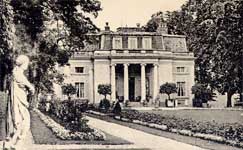
The original pavillon, with the tasteless addition of a slate Mansard third floor, probably late '20s.

Late '20s view of the front parterre, when the property was owned by M. Loucheur. While Minister of Housing, M. Loucheur pioneered the concept of the HLM, the French low cost housing developments.

The building on the right, at the corner of rue de la Machine and rue de la Princesse dates from 1883, designed by the architect Goury, when the Chateau was owned by Leopold Goldschmidt. About 15 years before, the original portals to the chateau had been replaced by the wrought iron grill pictured here, which stands today bearing on its pediment the inscription "Chateau Du Barry".

This grand entrance to the Du Barry property is along the Seine towards Bougival. The card labels it the "Chateau de Lancey", naming it after the Comtesse de Lancey, a rich American divorcée who acquired the Pavillon in 1879. From here, a network of carriage trails led up to the Pavillon, snaking its way by the Temple of Love and Duck Pond, shown here, as well as several other folies in the woods up the hill. The gates remain to this day, entrance to an apartment complex "Les Lions".

This little Temple of Love is at the base of the hill down by the Seine, on the way up to the Pavillon and can still be seen behind the "Les Lions" apartment buildings.

The "Duck Pond" pictured here is on the Du Barry property, part way down the hill towards Bougival. It still exists, very overgrown, but holding water thanks to its 19th c. concrete liner. As early as 1783 it also appears on the King's royal survey map of the property.

In its original form, la Machine de Marly was a huge complex, stretching nearly to the top of rue de la Machine. In later days, all that was visible up the hill was the Pipe. Now terminated at the top, one has the impression that the whole system is defunct, but there are still functioning, buried pipes beneath it, supplying the reservoirs of Louveciennes.
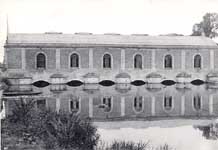
This is la Machine de Marly as most people at ASP knew it. Built in 1858, it was one of the replacements for the original machine of 1685. Several Impressionist painters from the area found it interesting subject matter.
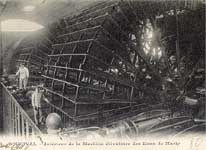
Six huge paddlewheels (40 ft. diameter by 13 ft. wide) were in the interior of the 1858 Machine. Its construction was encouraged by Napoleon III, who continued the supply pipes all the way to his favorite chateau in St Cloud.
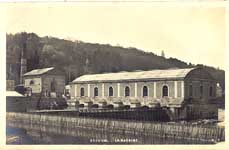
The machinery in the 1858 Machine was still in use up to 1963, at that point being used to generate electricity. The building was demolished in 1968, considered an obstacle to navigation.
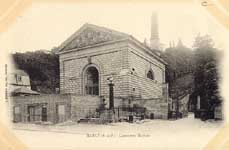
The array of pipes can be seen behind the smokestack of the "steam Machine". The "Service des Eaux de Versailles et Saint Cloud" company still uses these pipes to carry water pumped (by electricity) from wells in the Croissy aquifer up to reservoirs still in use since Louis XIV's era.
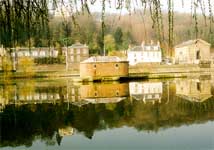
A more recent postcard of the Machine site, on which one can see, across the river, two of the original administrative buildings from the 1685 Machine (left and center-right), and the steam-driven Machine of 1811 (right). Reflected in the water, at the top of the hill is the pavillon Du Barry.















